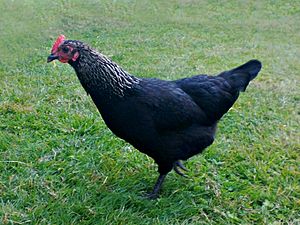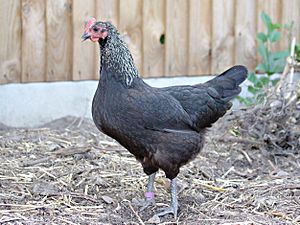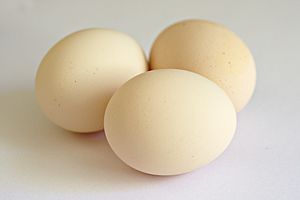Norfolk Grey facts for kids

14-month-old Norfolk Grey hen
|
|
| Conservation status | RBST: At risk |
|---|---|
| Country of origin | United Kingdom |
| Use | meat, eggs, exhibition |
| Traits | |
| Weight |
|
| Skin color | white |
| Egg color | tinted |
| Comb type | single |
| Classification | |
| PCGB | rare soft feather: heavy |
|
|
The Norfolk Grey is a special type of chicken that first appeared around 1910 near the city of Norwich, in Norfolk, England. It was created by Frederick W Myhill and was originally called the Black Maria. Today, it's a rare breed, meaning there aren't many of them left. The Rare Breeds Survival Trust considers them "at risk," so it's important to help protect them! These chickens are useful for both their eggs and their meat, and they also look quite striking.
Contents
A Look Back: The Norfolk Grey's Story
The Norfolk Grey chicken was first developed by a person named Frederick W Myhill. He started creating this breed even before 1914, possibly as early as 1908.
During World War I, Mr. Myhill went away for military service. While he was gone, his chickens were allowed to roam freely. When he came back, he found that his special chickens had mixed with other breeds. This meant he had to start all over again to recreate his unique chicken line!
The Norfolk Grey was first shown to the public in 1920. Back then, it was known as the Black Maria. In 1925, Mr. Myhill asked the Poultry Club of Great Britain to change the name. He wanted it to be called the Norfolk Grey because the name Black Maria wasn't very popular.
Sadly, the Norfolk Grey breed almost disappeared completely in the early 1970s. But in 1974, a small group of four birds was found on a private farm. Thanks to this discovery, the breed was saved and brought back from the brink!
What Makes Them Special?
Norfolk Greys are considered a "heavy breed" of chicken. This means they are bigger and more solid than some other types of chickens. We don't know for sure how this breed was made. However, people think that Birchen English Game chickens and possibly Duckwing Leghorns were used. The "game" part might explain why they are good for meat. The "Leghorn" part could be why they are good at laying eggs.
These chickens have a single comb on their head, which is a fleshy red growth. Their faces are red, and their eyes are black. Their legs are a dark slate grey or black color.
Appearance of Norfolk Grey Chickens
Norfolk Greys have very attractive feathers. The male chickens (called cockerels) have beautiful silver feathers on their neck, back, and wings. These silver feathers have black stripes. The rest of their feathers are black.
The female chickens (hens) have similar silver feathers on their neck, also with black stripes. But the rest of their body is covered in rich black feathers. They also have a special silver lacing pattern on their throat.
These chickens can grow to be a good size for meat if they are allowed to mature slowly. They are also often shown at poultry shows, where they can win prizes for their looks!
Size and Foraging
Norfolk Greys are excellent at finding their own food, like bugs and plants, when they are allowed to roam freely. This is called "foraging." Male Norfolk Greys usually weigh between 3.2 and 3.6 kilograms. Female Norfolk Greys typically weigh between 2.25 and 2.7 kilograms.
Why Keep Norfolk Greys?
The Norfolk Grey was originally bred to be a "utility bird." This means they are useful for two main things: producing eggs and providing meat.
Eggs
A healthy Norfolk Grey hen can lay about 150 to 220 eggs each year. These eggs are medium-sized and have a tinted (pale brown) color. What's great is that these chickens are known to keep laying eggs well even during the winter months!
Meat
Male Norfolk Greys (cockerels) make good table birds, meaning they are suitable for meat. It's best to let them grow slowly to get the best meat quality. Their meat often has a more "gamey" flavor compared to other common chicken breeds.



